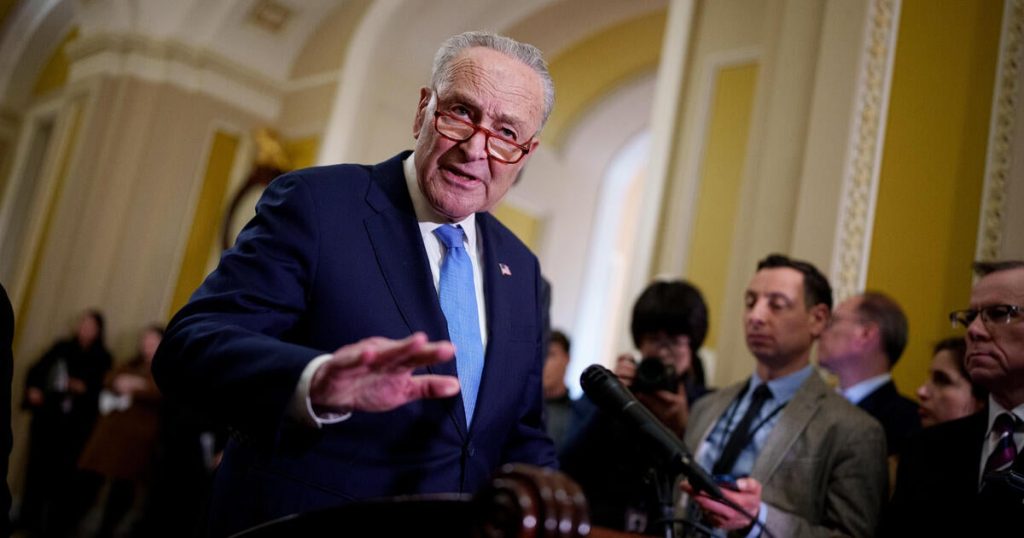In a critical standoff that threatens to result in a government shutdown, Senate Minority Leader Chuck Schumer has cautioned Republicans that they lack the necessary votes to pass a House-approved stopgap funding measure. As the Friday deadline looms, the contrasting approaches of the two parties regarding government funding have created significant tension. Senate Democrats are advocating for a shorter-term funding bill that would allow more time for negotiations, while House Republicans have pushed through a six-month funding resolution that faces strong opposition from Democrats.
| Article Subheadings |
|---|
| 1) The Dispute Over Government Funding |
| 2) House Republicans’ Legislative Strategy |
| 3) Senate Democrats’ Counterproposal |
| 4) The Role of Public Opinion |
| 5) Potential Consequences of a Shutdown |
The Dispute Over Government Funding
The current standoff centers around a House-passed continuing resolution that aims to keep the government funded through September. However, Chuck Schumer, who leads the Senate Democrats, pointedly remarked that the Republicans opted for a partisan approach, drafting the resolution without input from Democrats. This critical dispute highlights a recurring issue in American governance: bipartisan cooperation has often devolved into partisan gridlock, especially regarding budgetary matters. The statement from Schumer underscores the frustration felt by many in the Democratic party as they navigate the evolving political landscape.
House Republicans’ Legislative Strategy
The House Republicans managed to pass their six-month funding bill with the support of just one Democrat. This legislation, classified as a continuing resolution, proposes an increase in defense spending while simultaneously slashing non-defense expenditures below 2024 levels. Additionally, it allocates more funding for the Immigration and Customs Enforcement (ICE) agency. The swift movement of this measure through the House indicates a concerted effort by Republican leadership to solidify a united front as they push forward with their legislative priorities. House Speaker Mike Johnson celebrated the unity within his party, positing that such cooperation is essential for effective governance.
Senate Democrats’ Counterproposal
In response to the Republican approach, Senate Democrats are advocating for a more measured strategy—specifically, a shorter-term funding measure that would extend appropriations through April 11. This proposal seeks to provide additional time for negotiations and to craft a budget that accommodates bipartisan agreement. Following a lengthy deliberation among Senate Democrats, Senator Patty Murray of Washington and Representative Rosa DeLauro of Connecticut introduced this alternative continuing resolution to inform their colleagues of their intent to prioritize collaboration and thorough deliberation. Schumer emphasized the necessity of a clean budget proposal that would allow Congress to stabilize government funding while promoting meaningful negotiations.
The Role of Public Opinion
Public sentiment often plays a crucial role in shaping political decisions, and this funding dispute is no exception. Although Democratic leaders expressed disapproval of the House measure, it is essential to recognize that Democrats, too, generally wish to avoid a government shutdown. The decision to cancel votes in the House underscores Republican leaders’ intention to restrict the Senate’s ability to modify the existing bill, thus heightening the stakes of this partisan conflict. The implications of public opinion are significant, as a government shutdown could lead to widespread public dissatisfaction, affecting both parties’ support moving into future elections.
Potential Consequences of a Shutdown
The implications of a shutdown extend beyond immediate political maneuverings; they encompass real-world consequences for millions of Americans. Should funding lapse, numerous government services could be affected, including national parks, federal employee salaries, and educational programs. Additionally, organizations reliant on federal funding may face interruptions, potentially exacerbating issues such as public health and safety. Opponents of the House funding measure fear that the resolution could facilitate further austerity initiatives spearheaded by the Trump administration and its allies. This backdrop cultivates a precarious atmosphere as lawmakers navigate these contentious debates.
| No. | Key Points |
|---|---|
| 1 | Senate Minority Leader Chuck Schumer critiques the partisan approach of House Republicans. |
| 2 | House Republicans passed a six-month funding resolution with minimal bipartisan support. |
| 3 | Senate Democrats propose an alternative shorter-term funding solution through April 11. |
| 4 | Public opinion could factor heavily into the outcome of the budget negotiations. |
| 5 | A potential government shutdown may have significant implications for numerous government services. |
Summary
The debate over government funding remains a contentious battleground as both parties strive to assert their priorities before an impending deadline. With Chuck Schumer indicating a lack of bipartisan support for the House-passed resolution, it is evident that deep partisan divides will continue to complicate negotiations. The coming days will be pivotal as lawmakers reconcile differing priorities to prevent a government shutdown, a scenario that would have widespread repercussions for the American public.
Frequently Asked Questions
Question: What is a continuing resolution?
A continuing resolution is a type of legislation that allows the government to continue operations at existing funding levels, typically used when new appropriations bills have not been passed.
Question: What happens if the government shuts down?
A government shutdown results in the cessation of non-essential services, leading to furloughs for federal employees and disruptions in services such as national parks and public safety agencies.
Question: Why is bipartisan cooperation important in government funding discussions?
Bipartisan cooperation is crucial because it helps to ensure a smoother legislative process, allowing for more comprehensive solutions that reflect a broader consensus among lawmakers and are more likely to serve the needs of all citizens.


